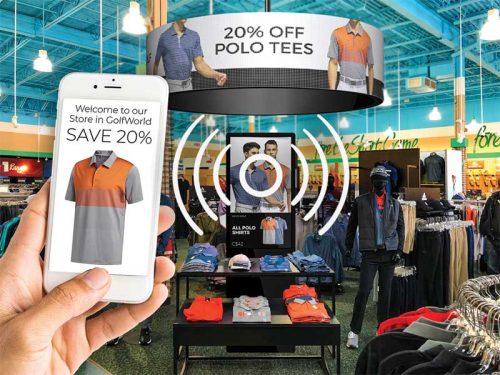Digital Signage: Understanding ROI, counting the costs
by | 20 May 2019 12:47 pm
By Andy McRae
 [1]
[1]One of the biggest advantages of digital signage is to deliver more relevant ads at the right place and time to the appropriate audience.
Digital signage can be complicated to understand. This is probably the topic that has been most written about and most asked about, yet, perhaps, the least understood when it comes to the digital signage space. Nearly every client the author’s company meets with asks the inevitable question, “What will my return on investment (ROI) be?” To formulate an answer, many people in the industry expand the question to be return on objective (ROO) or return on activation (ROA) which, in some cases, serves to make the matter even more confusing. That said, the real question one should be asking is why should this network be implemented and what will the impact be on the business?
An attempt at providing a straightforward answer
To calculate an ROI, two figures are needed. First, what is the investment (i.e. how much will the digital signage solution cost the company)? Second, what is the return or the revenue/value of the resultant action caused by the solution? If the second figure is higher than the first by a factor that is acceptable to the client, everything should be good, right? Not so fast.
Calculating the cost is easy; however, calculating the revenue or value is not. For instance, what if the client decides not to proceed with the project unless this calculation is completed in advance?
How does one calculate revenue/value in advance in digital signage?
 [2]
[2]One of the biggest advantages of digital signage is to deliver more relevant ads at the right place and time to the appropriate audience
To do this, it is important to start with the revenue calculation. Every digital signage project (or individual campaign) needs to have a clearly defined set of objectives. For example, this objective might be to have someone purchase something, sign-up for a loyalty program, share personal information to be marketed to in the future, or a means to improve the customers’ experience to ensure return visits. It could be all of the above or something completely different. It does not really matter as long as they are clearly defined.
As important as it is to have these clearly defined objectives, it only matters if one can measure the results. Using tactics like controls and baseline data offer the ability to define the current situation. Using unique codes helps to attribute an action to a specific campaign or message. Isolating the message to the channel that is being measured will offer a cleaner data set. Perhaps, most importantly, identifying the presence or absence of those factors that directly impact the desired action will provide a true picture of the effectiveness of the overall solution.
After identifying these objectives and devising a measurement methodology, a value needs to be assigned to them. An analysis of historical point-of-sale (POS) data may provide an indication of a sales increase resulting from different campaigns. Most retailers know what the value (in dollars) is assigned to a new client, a repeat customer, or a visit. An attempt is made to filter out any ‘noise’ (influence from other sources/channels) by assigning some type of unique code to a campaign, which allows for cleaner tracking.
There are several examples of sales increases for products that have been featured in a digital menu board, or a digital feature in-store. Having some kind of analysis to calculate the size of the opportunity gives one the sense of total available revenue. How many people are passing by a location without going inside? How many people are buying product ‘A,’ but not product ‘B’? How many people are browsing, but not buying or signing up for the loyalty program?
A potential revenue figure can be generated from all of these insights and data. Working backwards, one can identify a budget for the solution that will provide the desired return rate. Assuming a solution is possible, the project moves forward with a pilot that includes all the elements of the actual program to test the content strategy and its ability to achieve the desired conversion rates. Tweaks can then be made before an ultimate go or no-go decision is determined.
OK, so where are the ‘gotchas?’
 [3]
[3]An analysis of historical point-of-sale (POS) data provides an indication of a sales increase resulting from different campaigns.
This is not an exact science as there are continual emerging factors that influence the decision people make. While there is always an attempt to isolate the measurement to those results driven by the solution, it is not always possible. The best campaign can be derailed by an inadvertent outside influence, particularly given how the world is ultra-connected. Understanding and accounting for these outside influences is a huge benefit. One of the biggest advantages of digital signage is, should something extraordinary occur, the message can be changed immediately to reflect what just happened. For example, the objective may become damage control as a result of a high-profile athlete blowing out a sneaker as opposed to launching a new shoe line.
What to ask to ensure a successful digital signage project
- Have clear, valuable objectives been set?
- Does the content strategy include a call to action to achieve the objectives?
- Is the message being delivered to the desired audience?
- Is the presence of influencers known to help trigger the call to action?
- Is the right hardware being used to effectively deliver the content?
- Can the results of the program be continually monitored so they can be tweaked as necessary?
If the focus is too heavy on either the investment side or the revenue side—at the cost of the other—it can lead to a failed campaign. The author has seen many instances where the idea was great, but the execution was very underwhelming, which, ultimately, led to its failure. The alternative is also true; there are many examples where companies have spent a fortune on a sophisticated system, but did not have clear objectives or a content strategy that took advantage of the technology.
Measurement is not always easy. There is reluctance or at least perceived reluctance among many companies to share the results of their project whereby giving solution providers only a limited amount of real historical data on actual programs. Therefore, it is imperative for a company to find a partner that is capable of guiding it through the entire process. Many digital sign projects fail because the integrator could only focus on the hardware or software portion of the solution.
Is it still worth doing?
Yes—digital out of home (DOOH) and digital signage continue to grow at an incredible rate. The overall digital signage market will be worth $30 billion by 2025 with estimates now suggesting that outdoor digital signs will contribute upwards of 45 per cent of this total.
Technology is always getting better and less expensive. The sheer amount of data available makes measurement much more accurate, which, in turn, enables the messaging to be targeted precisely.
Many digital sign projects fail because the integrator could only focus on the hardware or software portion of the solution.
So, the next time a client asks any one of the questions mentioned at the beginning of this article, the simple answer is if they have clearly defined objectives with a valid measurement methodology and a well-defined expectation on the value of achieving the objectives, the likelihood for success is extremely high.
Andy McRae is general manager for Dot2Dot Communications, a full-service visual communications company that designs, develops, and manages immersive digital signage experiences. For more information,
visit www.dot2dotcommunications.com.
- [Image]: https://www.signmedia.ca/wp-content/uploads/2019/05/Dot2Dot_Westfield_Mall.jpg
- [Image]: https://www.signmedia.ca/wp-content/uploads/2019/05/Photo-courtesy-Dot2Dot-1.jpg
- [Image]: https://www.signmedia.ca/wp-content/uploads/2019/05/Photo-courtesy-Dot2Dot-2.jpg
Source URL: https://www.signmedia.ca/digital-signage-understanding-roi-counting-the-costs/